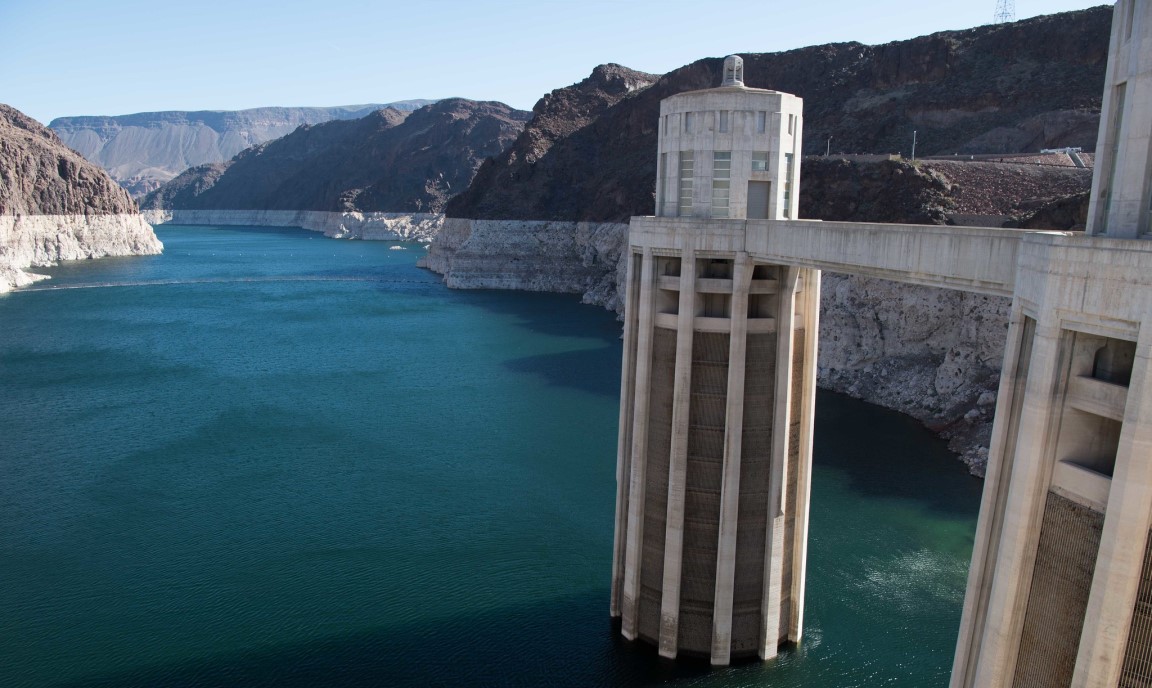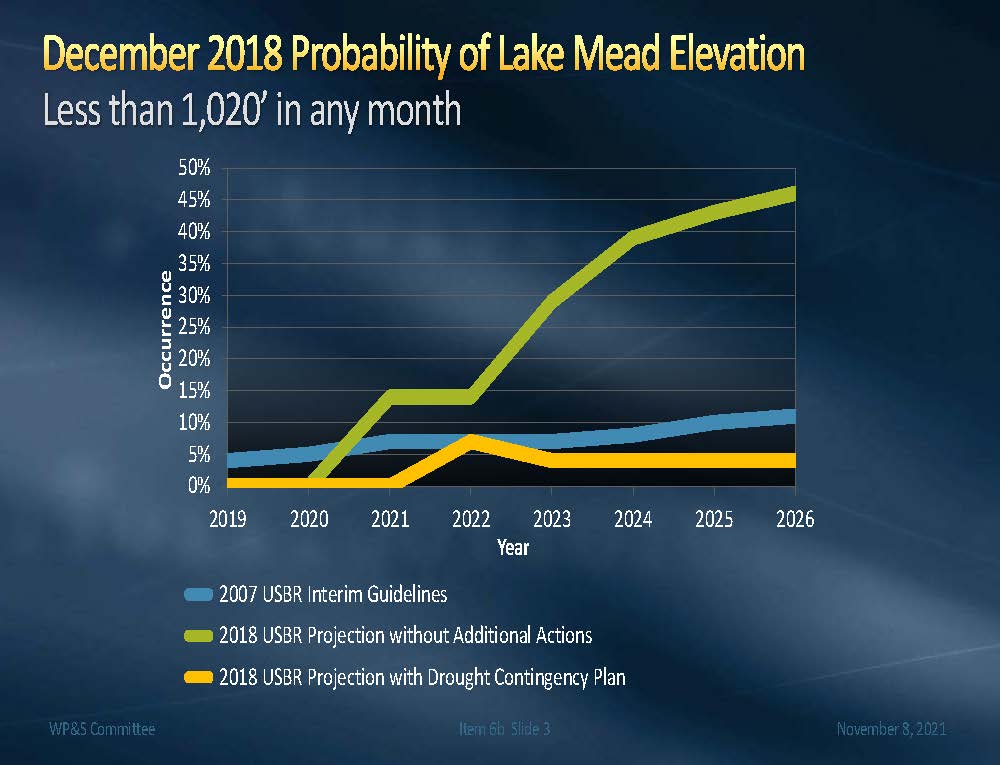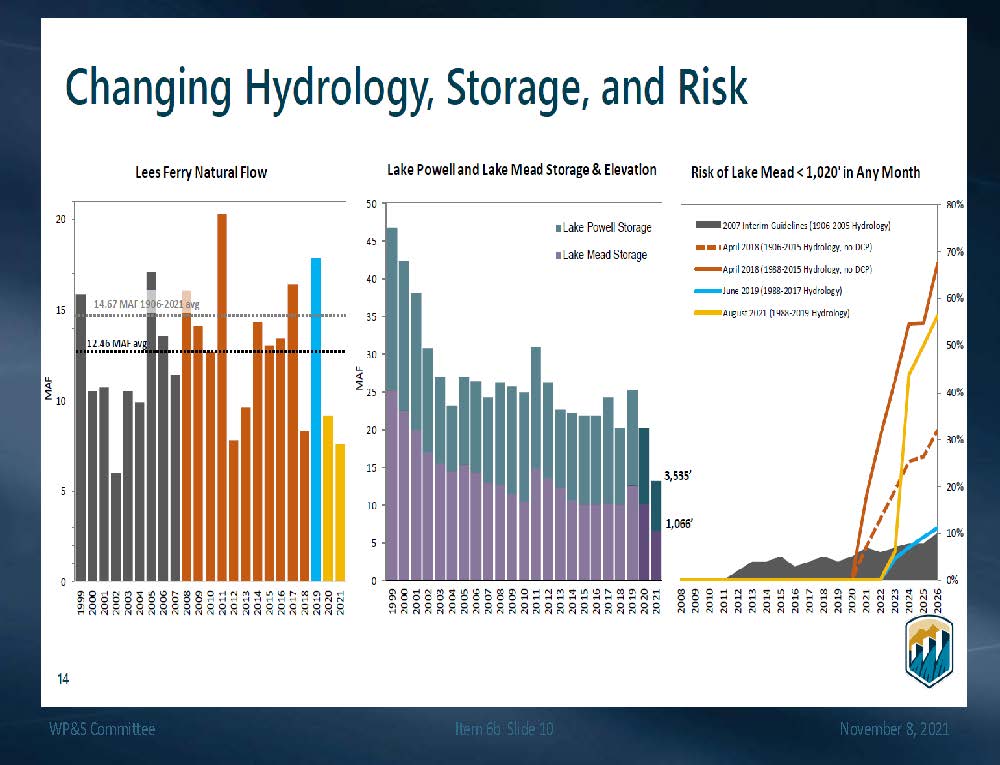While the negotiations have not yet started for the new guidelines for the management of the Colorado River, the lower basin states (California, Nevada, and Arizona) still have been meeting regularly to discuss the response to the worsening drought conditions, which have outpaced what was anticipated when the Drought Contingency Plan was adopted.
At the November meeting of Metropolitan’s Water Planning & Stewardship Committee, Colorado River Resources Policy Manager Shanti Rosset updated the committee members on the ongoing implementation of the Lower Basin Drought Contingency Plan.
The Lower Basin Drought Contingency Plan was adopted in the spring of 2019. It was intended to keep Lake Mead above critical reservoir elevations in order to preserve power generation and the ability to make full water deliveries.
In December of 2018, the modeling at the time showed that, without the DCP, the risk of Lake Mead declining to elevation 1020 feet was around 45% by the time the interim guidelines expire in 2026; with the DCP, the risk was around 10%
Unfortunately, the actual hydrology turned out to be worse than what was modeled. This slide shows the Bureau of Reclamation’s October 24 month study and the two-year probabilistic projections. In the minimum probable scenario, Lake Mead would decline to an elevation of 1025 feet by summer of 2023.
Ms. Rosset noted that for reference, actual inflow into Lake Powell in 2020 was below the Bureau of Reclamation’s minimum probable scenario. “This is a reminder that just because modeling results describe something as a minimum probable scenario doesn’t mean that things can’t get worse than that,” she said.
 The slide describes the Lower Basin Drought Contingency Plan implementation to date. The DCP added the requirement to store specified volumes of water in Lake Mead, known as DCP contributions, at certain lake elevations; that water is in addition to the shortages that Arizona and Nevada will take under the interim guidelines, and Mexico will take under Minute 323 and 319.
The slide describes the Lower Basin Drought Contingency Plan implementation to date. The DCP added the requirement to store specified volumes of water in Lake Mead, known as DCP contributions, at certain lake elevations; that water is in addition to the shortages that Arizona and Nevada will take under the interim guidelines, and Mexico will take under Minute 323 and 319.
In 2020, no DCP contributions or shortages were required. However, in 2021, the first DCP contributions were required for Arizona, Nevada, and Mexico. And in 2022, the first shortage declaration is almost certain, she said.
The slide below shows the ‘teacup diagram’ used by the Bureau of Reclamation to show the projected release from Lake Powell to Lake Mead and the elevations at each of those reservoirs.
“What’s worth noting in this slide is that unlike most years, where there’s a minimum release of 8.23 million acre-feet from Lake Powell to Lake Mead, next year will be a 7.48 million acre-foot release,” said Ms. Rosset. “Which means that even if hydrology is better than what’s included in the 24 months study projections, Lake Mead will be declining next year.”
If the implementation of the Lower Basin Drought Contingency Plan continues without modification, there will be shortage through 2026; Lake Mead will likely be at DCP contribution levels for California in 2024; there will be Tier Two shortages for Arizona, Nevada, and Mexico; and in 2025, 41% of traces show Lake Mead at or below critical elevation levels.
 “Based on the recent 24 months study results, it is clear that water managers may need to do more than what is required in the 2007 interim guidelines and the Drought Contingency Plan to keep Lake Mead above critical reservoir elevations,” said Ms. Rosset. “Just two and a half years from when the DCP was adopted in 2019 to this year’s August 24 months study, the risk of Lake Mead declining below elevation 1025 feet rose from around 10% of the traces to 41% of the traces. This brings us back to nearly the same level of risk of Lake Mead declining to critically low elevations as it was before the DCP was adopted.”
“Based on the recent 24 months study results, it is clear that water managers may need to do more than what is required in the 2007 interim guidelines and the Drought Contingency Plan to keep Lake Mead above critical reservoir elevations,” said Ms. Rosset. “Just two and a half years from when the DCP was adopted in 2019 to this year’s August 24 months study, the risk of Lake Mead declining below elevation 1025 feet rose from around 10% of the traces to 41% of the traces. This brings us back to nearly the same level of risk of Lake Mead declining to critically low elevations as it was before the DCP was adopted.”
Ms. Rosset noted that the current modeling also shows that, without the DCP, the risk of Lake Mead declining below elevation 1020 is in nearly 70% of the traces. “So we’re still getting a benefit from the DCP,” she said.
However, Metropolitan is prepared, she said. Even with the forecast showing significantly lower Lake Mead elevations through 2026, Metropolitan has sufficient supply for a full Colorado River Aqueduct through the interim period, approximately 1.3 million acre feet of ICS stored in Lake Mead, and the ability to make required DCP contributions forecasted for 2024 through 2026.
 The Lower Basin DCP included a provision referred to as the 1030 Consultation that requires the Secretary of the Department of Interior and Lower Basin states to consult and determine what additional measures will be taken to keep Lake Mead from declining below 1020 feet if any 24 months study for the minimum probable inflows, projects that Lake Mead elevations will be at or below 1030 feet within the following two years.
The Lower Basin DCP included a provision referred to as the 1030 Consultation that requires the Secretary of the Department of Interior and Lower Basin states to consult and determine what additional measures will be taken to keep Lake Mead from declining below 1020 feet if any 24 months study for the minimum probable inflows, projects that Lake Mead elevations will be at or below 1030 feet within the following two years.
So Arizona, Nevada, and California began discussing options in August when the 1030 Consultation trigger was hit. Recently, the Bureau of Reclamation hosted a webinar to provide information on reservoir conditions, modeling done by Nevada and Arizona, and options for additional actions being considered by lower basin managers in the 1030 consultation.
During the webinar, the Bureau of Reclamation noted that the average annual inflow into Lake Powell since the drought started in 2000 is almost 2 million acre-feet lower than the historical average. They also noted that Lake Powell and Lake Mead’s combined storage has been declining at a relatively steady rate, except for a few wet years in the 2000s. In 2021 alone, Lake Powell and Lake Mead’s combined storage declined by more than 5 million acre feet.
The graph on the far right shows that the risk of Lake Mead declining to 1020 has gotten worse over the last seven years. Modeling done by Arizona and Nevada showed that adding an additional 500,000 acre-feet per year to Lake Mead would keep lake levels above elevation 1020 in most traces, so based on this modeling, the lower basin states have been working to develop options to add 500,000 acre-feet to Lake Mead in 2022 and 2023.
“The good news is that the lower basin water managers have successfully worked together to develop approaches to keep Lake Mead above critical reservoir elevations in the past,” said Ms. Rosset. “Adoption of the DCP treaty minutes 319 and 323, the system conservation agreement. and other activities have collectively raised the elevation of Lake Mead 65 feet higher than it would have been without those efforts.”
“The approach coming out of the 1030 consultation is tentatively called the 500 Plus plan,” she continued. “Metropolitan is working with water managers in Arizona and Nevada to discuss options for potential supply and funding for a 500 Plus plan. It’s premature to say exactly where the sources of supply would be. But generally, they would come from the creation of additional system water and ICS. Potential partners include Mexico, Tribes, as well as NGOs.”
She noted that Metropolitan staff will continue to be engaged in the 1030 consultation. If discussions among the lower basin states are successful, a board action would be brought to the board, possibly in December.







